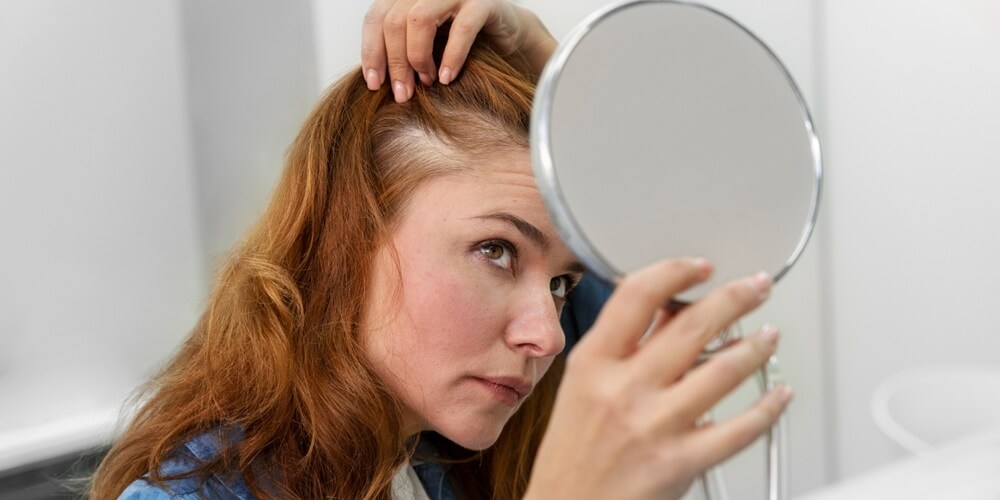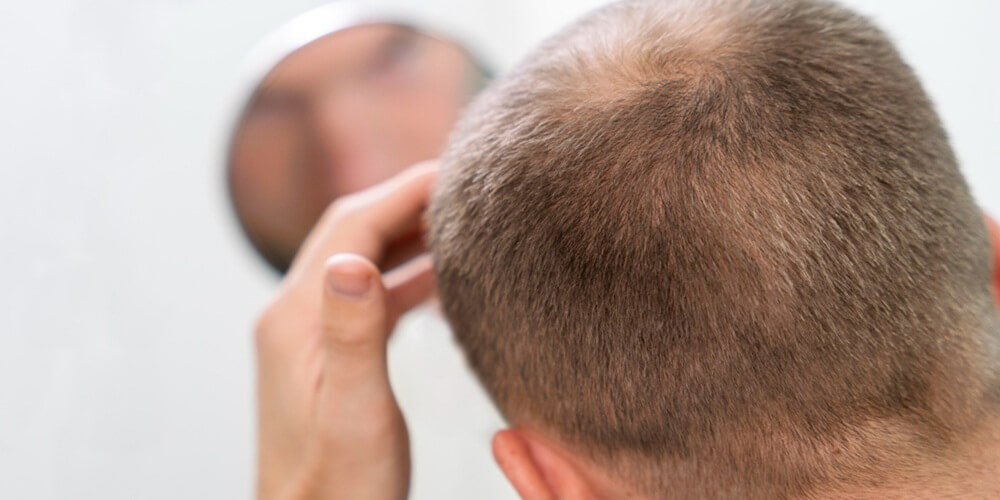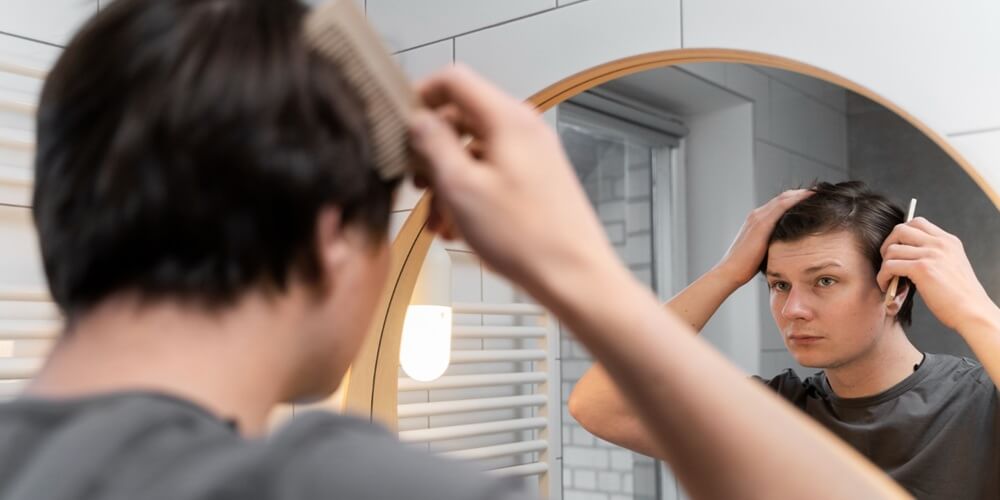Home » What is The Difference Between Hair Loss And Hair Thinning?

Hair loss, also known as alopecia, refers to the loss of hair from the head or body. When it affects the scalp, hair loss regularly takes the form of baldness. Hair thinning is not always loss of hair, but the shedding of loose hairs that can be seen in the hair brush or shower drain.
Hair loss occurs in many forms and can be caused by a wide variety of underlying conditions. Most hair loss is because of hereditary hormonal changes in both men and women. Some men experience baldness, while some have mild thinning or opt for a shaved head. Some women experience thinning rather than bald patches, but all depend on the degree of hereditary hair loss with age.
Hair loss can be classified into two categories. The first category, hair thinning, is defined as a partial loss of hair. The second category, baldness, is the complete loss of all body hair, including eyebrows, eyelashes and, all hair of the scalp. Both hair thinning and baldness can occur alone or simultaneously. In fact, scalp hair is affected by androgenic alopecia, hair loss which is secondary to androgens, and hair thinning which can be secondary to multiple disease processes. Follicular units are groups of individual hair shafts that cluster within compound follicles located on the scalp. These follicles include the supportive micro-vasculature, sebaceous glands and erector pili muscles. If follicular units decrease in number or size, then hair thinning will be observed.
The diameter of the hair follicle varies with age, health, gender, or ethnicity of an individual. More specifically, hair diameter can also decrease due to hormonal imbalances, chemotherapy, physical or emotional traumas, lack of nutrition, and deficiency of essential nutrients. Although the causes of hair loss may differ, the result is similar when decreased hair density and follicle diameter are observed together, because they will lead to visible hair thinning.

Hair loss (alopecia) is one of the most common issues that lead people to seek the advice of dermatologists for their scalp. Hair is an uncommon feature among mammals, and its loss occurs regularly throughout their lives. More than half of the male population experiences hair loss by the age of 50. Although it is men who are more affected by hair loss, it can also happen in women. Roughly 40 percent of women will experience hair loss during or after menopause. Hair loss distresses us, and men or women who begin to lose hair want to know what they can do about it.
The hair follicle is a highly organized structure, which arises from the embryonic epidermis and mesoderm, and it is deeply situated inside the skin. It is made up of an epithelial and dermal element. The hair follicle produces a structure composed mainly of keratin, which protrudes from the skin of the scalp. It undergoes cyclic transformations during hair growth. Each hair follicle proceeds through cyclical phases of growth (anagen) and rest (telogen), followed by a shedding phase (catagen). The telogen or resting phase is an essential process for the hair shape.
The onset of hair shedding usually progresses slowly, and most patients with telogen effluvium tend to normalize within six months. Recent studies highlight the need for a thorough differential diagnosis of hair loss, with clinical and optional trichoscopy evaluation, to distinguish between actual accelerated telogen effluvium and female pattern hair loss (FPHL), as well as to detect the coexistence of both conditions.
Hair thinning must not be confused with hair loss. Hair loss or alopecia is the disappearance of entire hair and its perifollicular structures not leaving almost no hair, in contrast with hair thinning. On the other hand, hair thinning more often clinically presents as hair thinning rather than alopecia, even though some hair follicles are present in the scalp for any of the hair density or diameter reduction that might be visualized or measured. Furthermore, hair thinning, although sometimes perceived by patients as hair loss, is still different from actual hair loss, since the hair follicle has at least some of its biological activities preserved and does not actually disappear.
Specific forms of hair thinning are as follows:
Mechanisms Hair thinning occurs because of the hair follicle’s miniature cycles or disturbed hair cycling combined with decreased hair production. These processes eventually cause hair follicle cycling phases to become shorter and falling hair to be replaced by progressively thinner, shorter, and less pigmented strands. Normal females may experience some hair thinning with advancing age, although the thinning becomes cosmetically unacceptable in others.
Normal male subjects can also display hair thinning with advancing age, especially after 30 years of age, mainly around the vertex, to lesser degree and with less cosmetic effect and discomfort as compared with males who have androgenetic alopecia. Male subjects with androgenetic alopecia often note hair thinning between 16 and 30 years of age.
Many people believe that hair loss and thinning hair are the same. However, there is difference between hair loss and thinning, because hair loss represents an increase in lost hairs and hair thinning is a reduction in sizes and diameter of existing hairs. When hair loss is in progress, the amount of existing hairs does not suffer a great reduction and, therefore, the number of lost hairs is, in general, within the range of what is considered normal.
Unlike hair loss, the density of present hair in hair thinning is generally within the normal range since the size/diameter of individual hairs has been decreased. The hair can be classified as Vellus hair and Terminal hair. Vellus hair is very thin and non-pigmented, whereas Terminal hair is thick and the colour of the hair is generally dark. Hair thinning occurs when the size/diameter of terminal hair decreases to such extent that it resembles Vellus Hair. Although it is generally considered a hair loss problem, it is a misnomer to call hair thinning as hair loss.

There are a few reasons for hair loss causes, including genetics that runs in your family, aging, some medicines, a stressful event, or hair loss after having a baby. The average person has 50 to 100 terminal hairs that grow and fall out a day. Terminal hairs, thick, long, pigmented hairs of the scalp, eyebrows, eyelash and in pubic and axillary areas. A biopsy of the scalp in individuals with hair thinning reveals a shorter growth phase and thinner hairs. Normal shedding of terminal hairs coincides with the growth of vellus hairs during the short growth cycle in the affected areas.
Topic | Details |
Laser/Red Light Therapy | May stimulate hair growth in cases of alopecia areata, hormone-related, or age-related hair thinning. |
Effectiveness of Laser Therapy | Further studies are needed to confirm long-term effectiveness. |
Genetic Influence on Baldness | Baldness can be inherited from either parent, more commonly from the mother’s side. |
Hormonal Role in Hair Loss | Hair follicles are sensitive to dihydrotestosterone (DHT), a testosterone variant. |
Key Enzyme Involved | 5-alpha reductase converts testosterone into DHT, influencing hair follicle sensitivity. |
Hair thinning signs occur when hair strands reduce in diameter or length, resulting in an overall decrease in hair mass. It is primarily a consequence of hair loss, as growing hair is produced by follicles that have not yet diminished in size or undergone the process of miniaturization. An early indication of hair thinning is frequently described as hair miniaturization, where the newly growing hair follicle is smaller than before.
Miniaturization refers to the progressive decrease in the diameter of the hair that emerges from the follicle. This process eventually leads to the degeneration, reduction in size, and impotence of the follicle itself—a gradual shortening and thinning until it no longer generates visible hair. Miniaturization is more often observed at the beginner stages of androgenic alopecia.
Both medical treatments of hair loss and self-care support can assist with hair loss conditions. Patients with alopecia areata could try scalp injections containing cortico-steroids. Topical minoxidil is over-the-counter and widely used for male- or female-pattern hair loss. The drug finasteride (Propecia) is widely used to control prostate enlargement, and it may reduce hair loss by up to half in men. A relatively low power laser light may also be used. It may not help you grow it back, but it will certainly slow down your hair loss and improve the way thinning hair looks. Hair transplant is a process where hair is moved from parts of the scalp with abundant hair to the bald spots. The patient can then be required to take minoxidil or finasteride for years to stave off additional hair loss. Other causes of scarring hair loss, like frontal fibrosing alopecia, are treated with prednisone, minocycline, and mycophenolate mofetil.
Doctors tell you you’re losing your hair in certain types and they treat different types. Different hair loss treatment recommendations can be given, depending on the amount of hair loss and thinning in men or women. Drugs such as finasteride and dutasteride restrict the activity of 5-alpha reductase, the enzyme that turns testosterone into the more potent dihydrotestosterone (DHT), and can stop the hair loss and promote new hair growth.
Topical minoxidil solutions open potassium channels and improve the blood supply to hair follicles. Biotin This nutrient especially helps to reinforce hair and stop it from falling. Treatment of deficiencies of nutrients such as B, C, D, E, zinc and iron is required for successful control of hair fall. Additionally, the appropriate protection from pollutants, a total hair regime and controlling stress is also essential in the fight against hair loss.

Although hair loss in women consists less often of changing sequences than in men, the process by which the hair thinning becomes apparent is almost the same. The hair thinning begins to draw attention when the scalp becomes more visible because the hair seems less dense than it used to be. This change in the hair’s appearance results from a growing number of follicles producing thinner, shorter, less pigmented hair.
In men, the situation differs, yet the same mechanisms cause hair loss. According to Ludwig et al., when hairs are exposed to androgens on the scalp, they shrink and produce thinner, shorter hair. If neither the hair nor the follicle dies, hair could grow back. In androgenetic alopecia, the transformation of terminal hair into miniaturized hair is suspected to be caused by an enhanced activity of 5 alpha-reductase as a factor in hormone metabolism. Testosterone is converted to dihydrotestosterone by the enzyme 5 alpha-reductase. They’re highly sensitive to dihydrotestosterone which causes them to transform into the tiny ‘vellus’ hairs – smaller, softer, unpigmented, downier ones.
Hair shedding is really the loss of hair, down to the root. It’s a relatively common condition, worldwide, that can be caused by an assortment of reasons including medical conditions, bad hair care practices, medications, hormonal changes (such as pregnancy) and more. Hair and scalp health specialists known as trichologists will be better equipped to not only diagnose the cause, but to recommend the right treatments to help to promote hair regrowth.
Thinning is a balding process where the hair strands become gradually thinner, resulting in thin-looking hair. There is no baldness like in total hair loss, the loss is more subtle in hair thinning and it can be in the form of a loss of both strands and roots alike.
Hello!